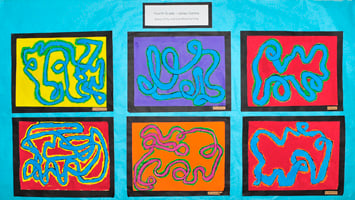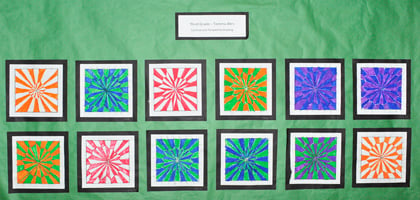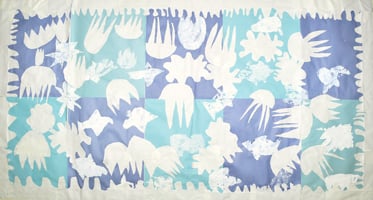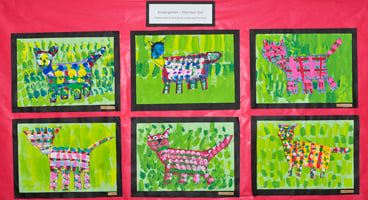Student Art Show
All School - Christo and Jeane-Claude
Probability, Unity and Variety Wall of Cans

The whole school demonstrated the concepts of probability, unity and variety by painting and assembling a wall of soda cans in the style of Christo and Jeane-Claude's "Gasometer".
Students used randomizing tools to determine the color ratio of the yellow, red, dark blue, light blue, white and green cans. After the cans were painted, students taped the cans into place, carefully maintaining these ratios throughout the piece.
Students discovered that unity is created when elements are repeated, that variety is created when elements are contrasted, and that one can emply math to determine aesthetic choices.
5th Grade - Aztec Calendar Stone

The 5th Grade learned proportion and three-dimensional concepts by making a paper mache replica of the Aztec Calendar Stone. Students learned that the Calendar Stone was used by the Aztecs to accurately measure time. Students also learned that the original Calendar Stone, now in the National Museu of Anthropology in Mexico City, is 12 feet wide with a weight of over 20 tons. For several practical reasons our replica, though in proportion, is 7 feet and weighs about 15 pounds.
Students created the stone using paper mach (glue andpaper) to cover a foundation that Mr. C made from cardboard boxes. The 5th Grade drew pieces of the calendar that were merged together and traced using an overhead projector. All the drawings involved in this project are contour (outline) that the students drew.
The 3rd Grade students made smaller versions of the Calendar Stone.
4th Grade - James Sienna
Unity, Contrast, Space, & Mood Project

Students learned Unity, Mood, Contrast and Space by making a James Sienna Endless line painting. Students learned that artists unify artworks by repeating and/or arranging elements. James Sienna repeats color choices and arranges his line to create one mass. Students learned that artists choose contrasting colors and other elements to create interest in their work. James Sienna uses stark differences in color choices so that his endless line will emerge from the background. Students learned that space is the area in and around shapes. James Sienna overlaps his line to create the illusion of depth in pictures. Students learned that lines can inspire mood in an art piece. James Sienna pieces have an energetic, yet controlled feel to them.
Students practiced drawing an overlapping endless line with markers. Students painted a squiggly line. When it was dry, students outlined the line with a marker. Students outlined the outline with at contrasting color. Students filled in the background with another color to finish the piece.
3rd Grade- Tomma Abts
Contrast, Perspective, and Measuring Drawing

The 3rd Grade demonstrated the concepts of contrast and the skills of measuring by creatin a drawing in the style of a Tomma Abts perspective picture.
Students measured and labeled every inch of a given square. They then carefully drew diagonal lines that passed through the center of the square. The students then bisected each of the lines to create a crooked ring. They then carefully colored the design so that no section of the sam color would touch.
2nd Grade - Kcho
Form & Color Mixing Clay Boats
The 2nd Grade created an art installation in the style of the Cuban artist Kcho. By creating clay representations of the boats used by Cuban Refugees, students developed the skill of joining clay. To create different values of brown, they practiced color mixing by selecting and combining different proportions of red, yellow, blue, white and black.
1st Grade
Printing, Silhouette, Value & Abstract Art Collage

The 1st Grade demonstrated the concepts value, silhouette and abstract art and the skill of printing by creating a collage in the style of Henri Matisse's "Polynesian Sea".
Students created printing plates from styrofoam trays in the abstract silhouettes of sea creatures. These were printed on the communal background. White collage paper in the shape of coral, jellyfish, and seaweed were added to complete the design.
Kindergarten - Thornton Dial Cats
Pattern, Value, Background & Science

Students learned Pattern, Value, Background & Science Art by making Thornton Dial Cats. Students learned that patterns are created by repeating elements in an order. Students learned tht value is the darkness or lightness of an object. Students learned that artists commonly put figures in a background space. Students learned that people in other fields, especially science, use art to demonstrate observations.
Students drew and painted large cats and painted them with patterns. Students then created a grass background by mixing different values of green using only yellow and blue paint. Students cut their cats out and glued them to the background.
Pre-Kindergarten - Marc Rothko
Color Mixing & Rectangle Painting

The Pre-Kindergarten demonstrated the concept of color mixing by creating a painting in the style of Marc Rothko.
Students connected dots to form rectangles. Students mixed primary colors to form the colors orage, green and purple. The students painted the rectangles with the mixed colors.
